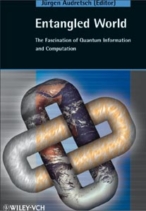by Jürgen Audretsch (ed.), Wiley-VCH. Hardback ISBN 3527404708, £22.50 ($33.80).
Entangled World is a 2006 English translation of “Verschränkte Welt – Faszination de Quanten” (2002). Based on lectures about “physics and philosophy of correlated quantum systems” given at the University of Konstanz in the winter semester of 2000/2001, it presents a clear and simple overview of quantum mechanics and its applications (especially via entanglement) to novel technologies like quantum computing.

The lectures in the book are written in a clear and informal style, but are aimed at a level that is too high for an average non-physicist and too low for a practising physicist. Given that they are based on university lectures, this is perhaps not surprising and this book might best be thought of as supplementary reading for a proper quantum mechanics course.
For example, bra and ket notation are introduced, but you’d have to know what vectors and complex numbers are to follow the explanation. A discussion of Bell’s inequality assumes that the reader knows what a probability density is, as well as what an integral means. Those who do not have a background in mathematics or physics would probably still find this an interesting read, but they would have to be willing to skip over many of the details; finding a simpler book might be a better idea for them.
A practising physicist who has not had time to keep up with recent advances in quantum computation and other fields dealing with quantum information may well find sections of this book useful as quick and painless introductions to emerging quantum technologies – ones that genuinely go beyond the possibilities offered by an arbitrarily large amount of classical hardware. Those with a philosophical bent are likely to find much of interest, as there is a fair amount of historical information and interesting quotes with emphasis on the thoughts of physicists rather than professional philosophers.
Although the lectures are by a number of different authors, the book flows well and the notation is consistent. With the slightly rough translation, one could easily think that this was written by a single author.
With respect to the translation, I am aware that it is all but impossible for anyone who is not a native speaker to make a perfectly smooth translation and in many ways the translation is quite good. That said, a final pass by a native English speaker would have been useful. The same criticism could be levelled at many publishers, but it doesn’t seem unreasonable to ask for the same level of editing that goes into a book originally written in English. Even the short description of the book at is written in rather poor English. Come on publishers – there is no shortage of underpaid physicists who would make small corrections to translated texts for you!
Overall, I like the layout. Numerous illustrations help to make the text clear, and Erich Joos’ chapter on decoherence has the useful feature of separating out material “for physicists” into shaded boxes, much as New Scientist used to do many years ago, so that a popular article could include a piece of higher-level information without disturbing the overall flow of the text. This has always seemed a great idea to me and I wish that it would come back into vogue.
A few interesting points are raised that would even be of interest to a relatively advanced physics student, especially with respect to decoherence, which receives little treatment, if at all, in most of the classic textbooks. Another noteworthy feature of this book is the inclusion of experimental information in the form of plots and sketches of how pieces of equipment are put together.
All in all the book has much to offer and is reasonably priced, but one should be aware of the level at which it is pitched.





